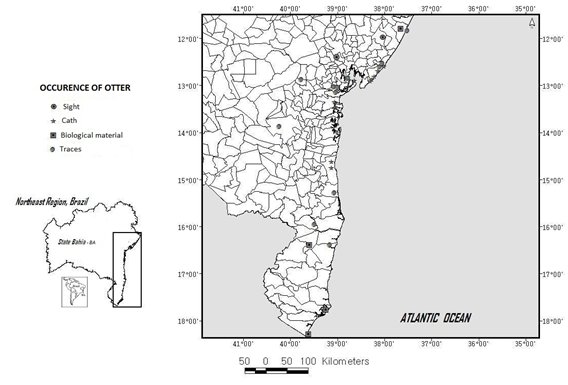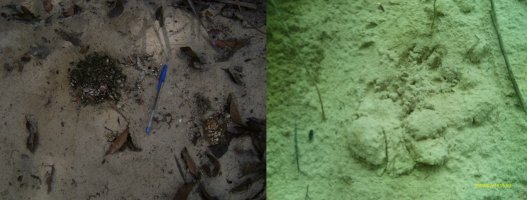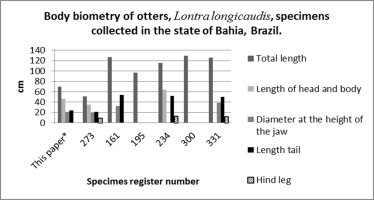IUCN/SSC Otter Specialist Group Bulletin

|
©IUCN/SCC Otter Specialist Group Volume 29 Issue 2 Pages 70 - 120 (June 2012) Citation: Souto, L.R.A. (2012). New Occurrence Data of Neotropical Otters Lontra longicaudis (Olfers, 1818), in Bahia State, Northeastern Brazil . IUCN Otter Spec. Group Bull. 29 (2): 80 - 94 New Occurrence Data of Neotropical Otters Lontra longicaudis (Olfers, 1818), in Bahia State, Northeastern Brazil Luciano R. Alardo Souto 1
1Curatorship Sector of Instituto Mamíferos Aquáticos (IMA): Av. Pinto de Aguiar, Rua dos Radioamadores, 73, - Pituaçú. CEP: 41741080. Salvador, Bahia, Brasil.. e-mail:
lucianoalardo@yahoo.com.br
|

|
| Received 9th March 2011, accepted 25th May 2012 |
| Abstract: Very little is known about the neotropical otter (Lontra longicaudis) in the Brazilian state of Bahia. The purpose of this study was to record the number and location of sites where otters have been recorded in this area. Between 1988 and 2009, there were 29 records of otters in Bahia, including the collection of 13 living (9) and dead (4) otters. Of the live otters, 61.53% were adults and 38.46% pups. Five of these were males, five were females and the gender of three individual was not established. The majority (41,37%) of otter records were made in northern Bahia, and 31.03% were made in southern Bahia (31.03%). Eight records (27,58%) were made in the area around Todos os Santos bay, including seven sites where the species was not previously known to occur. No observations were made in the mid-west region of the state, so future studies are needed in this region. |
| Keywords: distribution range, neotropical otter, northeastern Brazil. |
| Française | Español | Português |
INTRODUCTION
The neotropical otter (Lontra longicaudis) is classified as ‘Data Deficient’ by the International Union for Conservation of Nature (IUCN) ( Waldemarin and Alvarez, 2008 ), with an equivalent classification used by the Brazilian Institute of Environment and Renewable Natural Resources ( IBAMA, 2001 ). This means there are insufficient data available to accurately ascertain the conservation status of this species. In the few Brazilian states where lists of endangered species already exist, such as Minas Gerais, Espírito Santo, São Paulo, Paraná and Rio Grande do Sul , otters are classified as ‘Vulnerable’ ( Silva, 1998 ; Indrusiak et al., 2003 ; Mikich and Bérnils, 2004 ; MMA, 2010 ; Passamani and Mendes, 2007 ). One problem faced by conservationists is the lack of detailed knowledge concerning population size and distribution of the species.In 2010, Regulation n. 88 approved the Plan of National Action for the Conservation of Ariranha (Pteronura brasiliensis) - which includes neotropical otters (L. longicaudis) - in order to protect those two species. This information is required to assess the conservation status of the species and to track spatial and temporal changes, and is therefore of crucial importance for the development of species conservation strategies ( Foster-Turley et al. (1990) ). To comply with goal n. 2.6 of the Executive Summary of the Plan of Action for Conservation of Ariranha ( MMA, 2010 ), we need to confirm the current distribution of otters (Lontra longicaudis), with emphasis on the areas North and Northeast of Brazil.
The neotropical otter appears to have a widespread range throughout South America, extending from Mexico to Argentina ( Chehébar, 1990 ; Mason, 1990 ; Parera, 1996 ; Emmons, 1997 ; Gallo, 1997 ). In its Brazilian territory, research has focused on the southern and southeastern regions ( Pardini, 1998 ; Waldemarin and Colares, 2000 ; Quadros and Monteiro-Filho, 2001 ; Alarcon and Simões-Lopes, 2004 ; Kasper et al., 2004 ; Carvalho et al.,2010 ) and it has received little research attention in the north, despite reports of its presence in the states of Pernambuco, Paraíba, and Bahia ( Fonseca et al., 1994 ; Almeida, 1997 ; Araújo and Souto, 2004 ; Leal, 2008 ; Muritiba, 2008 ). Data from these areas tend to originate from occasional and isolated reports that lack complementary information. More information is needed in order to establish the conservation status of the neotropical otter in Bahia and other parts of northern Brazil.
The neotropical otter is usually found in aquatic environments, including freshwater (streams, rivers, and lakes) and saltwater environments (bays, lagoons, and rivers) ( Larivière, 1999 ; Carvalho-Jr., 2007 ). On land, the most characteristic indirect signs of otters are their spraints (faeces), which otters frequently deposit in prominent places as territorial markers ( Kasper et al., 2004 ). Otter spraints are easily identifiable, as they contain fish scales, remains of crustacean exoskeletons and bones of fish, small mammals, amphibians and birds ( Pardini, 1998 ; Quadros and Monteiro-Filho, 2001 ; Carvalho et al., 2010 , Rheingantz et al., 2011 ).
The purpose of the current study was to use a variety of methods, including spraint collection, to report the distribution of the neotropical otter in the northern Brazilian state of Bahia.
ANIMALS, MATERIAL AND METHODS
The current study collated evidence for the presence of neotropical otters in Bahia. Indirect evidence included records of footprints and spraints, and historical reports of otters in the region, obtained through a bibliographical review ( Almeida, 1997 ; Araújo and Souto, 2004 ; Siciliano and Franco, 2005 ; Leal, 2008 ; Muritiba, 2008 ). These data were combined with direct evidence of otters, including live animal confiscations, collection of carcasses and direct sightings of otters. All records were collected in an ad hoc manner ( Table 1 ). For both live and dead specimens, the total length of the individual and a further four morphological measurements (length of head and body, diameter at the height of the jaw, tail length and hind leg length) were taken ( Figure 3 ). Age class and gender were also recorded where possible.
Records were grouped into geographic areas: (north (N) and south (S) of the state and the area of Reconcavo Baiano (RB) (which surrounds Todos os Santos bay). These areas were analyzed by percentage values. The species was considered to occur in an area if that area presented at least one type of otter sign or where a direct observation of the species was made. Biological material from the recovered specimens and spraints collected in Pojuca, Caraipe and Caraipé rivers were deposited in the Scientific Collection of the Aquatic Mammals Institute (Instituto Mamíferos Aquáticos - IMA).
RESULTS AND DISCUSSION
Between 1988 and 2009, 13 neotropical otter specimens (9 living and 4 dead) were collected from Bahia. These data were combined with indirect (n=14, spraint and track reports, six of which originated from the bibliography and eight from unpublished material ) and direct observations (n=2) of otters, resulting in the identification of a total of 29 sites in Bahia that were considered positive for otter occurrence ( Figure 1 , Table 1 ).

|
|
Figure 1.
Occurrence of otters, Lontra longicaudis, collected in Bahia, 1988-2009. The box represents the coastal area of Bahia, which corresponds to our study area. (click for larger version) |
Most of the records (37.93%, n=12) originated in the northern coast of Bahia. This may be partly because of a disproportionate presence of researchers in this area. The rivers of this region with records of otters were, from north to south, Cromaí, Quiricó, Pojuca and Capivara ( Araújo and Souto, 2004 ; Figure 2 ). In the south of Bahia, evidence was found for neotropical otters in 31.03% (n=9) of all reported occurrence sites in Bahia. These included the rivers Contas, Almada, Maroin, Buranhém, and Mucuri ( Siciliano and Franco, 2005 ; Rebouças and Affonso, 2006 ). There were only two historical records of neotropical otters in the Recôncavo Baiano region. A further seven records were made during the current study, meaning that 27,58% (n=8) of all reported occurrence sites in Bahia are in this region. Evidence of otter presence was found in the rivers Catu, Tanquinho, Paraguaçu, Dona, Caraipe and Caraipé (the latter two rivers are effluents of the Jaguaribe river) ( Almeida, 1997 ; Araújo and Souto, 2004 ; Leal, 2008 ; Muritiba, 2008 ). It is worth emphasizing that this species was not previously known to occur in these rivers.

|
|
Figure 2.
Spraint and footprint of neotropical otters Lontra longicaudis in Quiricó rivers (12°17'52.5"S e 38°09'18.4"W; Photos: Luciano R. Alardo Souto) (click for larger version) |
The biometric values of the live otters collected was in line with previous reports for this species, with length varying from 51 to 130 cm and weight varying from 6 to 12 kg ( Figure 3 ). These otters were identified as five males (38,46%), five females (38,46%) and three individual of uncertain gender (23,07%). It would be interesting to further explore the demographic aspect of this species in this region, because the current data set is too small to permit valuable conclusions from being drawn. Of these live individuals, 61.53% were adults and 38.46% were pups (with evidence of nursing). Neotropical otters are believed to nurse for three to four months and stay with their mother for approximately one year ( Nowak, 1991 ; Parera, 1996 ). Therefore, the relatively high number of observations of cubs was unexpected, and may reflect the pups’ inexperience regarding the dangers of leaving parent care and their curiosity about the environment outside the den. It is also possible that the pups were orphaned or abandoned by their parents. Pups collected from Catu and Almada rivers following floods in the region, suggesting that this may be the case.
 |
|
Figure 3.
Body biometry of otters, Lontra longicaudis, specimens collected in the state of Bahia, Brazil (* Sampaio, S.S., personal communication). (click for larger version) |
CONCLUSION
This study reports the distribution of neotropical otters in Bahia, Brazil, including the identification of seven rivers where this otter was not previously known to occur. These findings suggest that neotropical otters are present throughout the coast of Bahia, with evidence found in nine of the state’s twelve hydrographic basins ( SRH, 2004 ). There is a need for more studies on the distribution and ecology of otters in Bahia, particularly focused in the mid-west region, in order to accurately assess their conservation status in this region so that conservation measures may be developed where necessary.
Acknowledgements - We thank all the members of the IMA that helped in the collections and rescues performed; Claudia M. Araújo, Renata Batista, Luciano W. Dórea-Reis and Ricardo O’Reilly Vasques to participate of the first studies the about of the distribution of otters in Bahia; Anderson Abbehusen, Amorin Reis, Cláudio L.S. Sampaio, Marco Freitas, Maria do S.S. Reis, Luíz A.S. Boaventura and Sidnei Sampaio for their reviews, valuable suggestions, and kindly granted data; Daniel Henriques de Araújo for translating the abstract; and Raquel S. Velozo for constructing the distribution map.
REFERENCES
Alarcon, G.G., Simões-Lopes, P.C. (2004). The Neotropical otter Lontra longicaudis feeding habits in a marine coastal area, Southern Brazil. IUCN Otter Spec. Group Bull.
21(1): 24-30.
Almeida, V. G. (1997). Aspectos da fauna. In: Baía de Todos os Santos: diagnóstico sócio-ambiental e subsídios para a gestão. Gérmen/UFBA-NIMA, Salvador, 1-13.
Araújo, C.M., Souto, L.R.A. (2004). Actual distribution of Lontra longicaudis in the state of Bahia, Brazil. In: IX International Otter Colloquium. Frostburg, Maryland, USA.
Carvalho-Junior., O. (2007). No rastro da lontra brasileira. Bérnuncia, Florianópolis.
Carvalho-Junior, O., Birolo, A.B., Macedo-Soares, L.C.P. (2010). Ecological aspects of neotropical otter (Lontra longicaudis) in Peri lagoon, south Brazil. IUCN Otter Spec. Group Bull.
27(2): 104-115
Chehébar, C. (1990). Plan de acción para lãs nutrias de Latinoamerica. In: Foster-Turley, P., Macdonald, S.M., Mason, C.F. (Eds.). Otters: an action plan for their conservation. Otter Specialist Group/IUCN: 67-73.
Emmons, L.H. (1997). Neotropical rainforest mammals: a field guide. 2° ed. The University of Chicago Press, Chicago.
Fonseca, G.A.B., Rylands, A.B., Costa, C.M.R., Machado, R.B., Leite, Y.L.R. (1994). Livro vermelho das espécies Ameaçadas de extinção. Fundação Biodiversitas, Belo Horizonte: 459pp.
Foster-Turley, P., Macdonald, S., Mason, C.F. (1990). Otters: an action plan for their conservation. Otter Specialist Group/IUCN.
Gallo, J.P. (1997). Situación y distribución de lãs nutrias em México, com énfasis em Lontra longicaudis
annectens Major, 1897. Rev. Mex. Mastozool., 2: 10-32.
IBAMA (2001). Mamíferos Aquáticos do Brasil: Plano de Ação. Versão II, Brasília.
IBAMA (2005). Protocolo de conduta para encalhes de mamíferos aquáticos : Rede de encalhes de mamíferos aquáticos do Nordeste. Edições IBAMA, Recife.
Indrusiak, C., Eiziriki, E.
(2003). Carnívoros. In: FONTANA, C. S.; BENCKE G. A REIS, R. E. (Orgs.). Livro vermelho da fauna ameaçada de extinção do Rio Grande do Sul. Porto Alegre: EDIPUCRS. 507-534.
IUCN (2009). IUCN Red List of Threatened Species. Version 2009.1. Available:
http://www.otterspecialistgroup.org/Species/Lontra_longicaudis.html
(09.08.2011).
Kasper, C.B., Feldens, M.J., Salvi, J., Grillo, H.C.Z. (2004). Estudo preliminar sobre a ecologia de Lontra longicaudis (Olfers) (Carnivora, Mustelidae) no Vale do Taquari, sul do Brasil. Rev. Bras. de Zool., 21: 65-72.
Lariviére, S. (1999). Lontra longicaudis. Mammalian Species. 609: 1–5.
Leal, A.E.F. (2008). Dieta e caracterização dos sítios utilizados por Lontra longicaudis (Olfers, 1818) (Carnivora: Mustelidae) na Região do Rio Caraípe, Aratuípe – Bahia. (Monografia). Faculdade de Tecnologia e Ciências, Salvador.
Mason, C.F. (1990). An introduction to the Otters. In: Foster-Turley, P; Macdonald, S., Mason, C. Otters: An Action Plan for their Conservation. Otter Specialist Group/IUCN. 4-7.
Mason, C.F., Macdonald, S.M. (1987). The use of spraints for surveying otter Lutra lutra populations: an evaluation. Biological Conservation, 41: 167-177
Mikich, S.B., Bérnils, R.S. (2004). Livro vermelho da fauna ameaçada no Estado do Paraná. Available:
http://www.pr.gov.br/iap
. (20.02.2009).
MMA. (2010). Sumário Executivo do Plano de Ação para Conservação da Ariranha. Brasília. Available on: <
http://www.icmbio.gov.br/biodiversidade/fauna-brasileira/lista-planos-de-acao-nacionais
>
Muritiba, L.L. (2008). A influência da estrutura do habitat na ocorrência da Lontra
longicaudis (Olfers, 1818) no rio Caraipé e rio da Dona, Aratuípe - BA. (Monografia). Universidade Católica do Salvador, Salvador.
Nowak, R.M. (1991). Walker's mammals of the world. v2. John Hopkins University Press, London.
Pardini, R. (1998). Feeding ecology of the neotropical river otter Lontra longicaudis in Atlantic Forest strem, south-eastern Brazil. Journal of Zoology, London, 245: 385-391.
Parrera, A. (1996). Las “nutrias verdadeiras” de la Argentina. Boletin Técnico (Fundação Vida Silvestre Argentina), 21: 1-38.
Passamani, M., Mendes, S.L. (2007). Espécies da fauna ameaçadas de extinção no Estado do Espírito Santo. Instituto de Pesquisas da Mata Atlântica, Vitória.
Quadros, J., Monteiro-Filho, E.L.A. (2001). Diet of the neotropical Otter, Lontra longicaudis, in an Atlantic Forest area, Santa Catarina State, Southern Brazil. Stud. Neotrop. Fauna Environ., 36: 15-21.
Rebouças, L.T., Affonso, R.O. (2006). Dieta da lontra, Lontra longicaudis (Olfers, 1818) (Mammalia, Mustelidae) em um trecho do médio rio de Contas, Jequié, Bahia. In: Livro de Resumos do I Congresso Sul-Americano de Mastozoologia, UFRGS, Gramado, p.37.
Rheingantz, M.L., Waldemarin, H.F., Rodrigues, L., Moulton, T.P. (2011). Seasonal and spatial differences in feeding habits of the Neotropical otter Lontra longicaudis (Carnivora: Mustelidae) in a coastal catchment of southeastern Brazil. Zoologia 28 (1): 37–44.
Silva, J.A.S. (1998).
Lontra longicaudis (Olfers, 1818). In: Machado, A.B.M.; Fonseca, G.A.B.; Machado, R.B.; Aguiar, L.M.S.; Lins, L.V. (Eds.). Livro vermelho das espécies Ameaçadas de extinção da fauna de Minas Gerais. Fundação Biodiversitas, Belo Horizonte. pp. 96-98.
Siciliano, S., Franco, S.M.S. (2005). Catálogo da coleção de mamíferos aquáticos do Museu Nacional. FIOCRUZ/ENSP, Rio de Janeiro: 1-44.
Superintêndencia de Recursos Hídricos - SRH. (2004). Bacias Hidrográficas da Bahia. SRH, Salvador.
Waldemarin, H.F., Alvarez, R. (2008). Lontra longicaudis. In: IUCN 2011 Red List of Threatened Species. Accessible on: <
http://www.iucnredlist.org/
>
Waldemarin, H.F., Colares, E.P. (2000). Utilisation of resting sites and dens by the neotropical river otter (Lutra longicaudis) in the south of Rio Grande do Sul State, southern Brazil.
IUCN Otter Spec. Group Bull
. 17
(1): 14-19.
Résumé : Nouvelles Données de Présence de Loutre à Longue Queue Lontra longicaudis (Olfers, 1818), dans l’État de Bahia au Brésil
On sait très peu de choses sur la loutre à longue queue (Lontra longicaudis) dans l'état Brésilien de Bahia. Le but de cette étude était d'enregistrer le nombre et la localisation précise des sites ou la loutre était présente sur ce territoire. Entre 1988 et 2009, 29 données sont recensées comprenant notamment l’observation visuelle de 13 loutres. Parmi ces loutres, 61,53% étaient des adultes et 38,46% des juvéniles. Cinq de ces individus étaient des males, cinq étaient des femelles et le sexe de trois individus n'a pas pu être identifie. La majorité (27,58%) des données émanent du nord de Bahia, et 31,03% sont localisées dans le sud. neuf données (41,37%) sont issues d’une zone autour de la baie de Todos os Santos parmi lesquelles 7 sites ou l’espèce n’était pas connue avant cette enquête. aucune observation n’a été faite dans le mid-ouest de l'état c’est pourquoi de futures études seraient nécessaires dans ce secteur géographique.
Revenez au dessus
Resumen: El título no ha sido traducido aún
texto no está disponible todavía
Vuelva a la tapa
Resumo: Dados sobre Novas Ocorrências de Lontras Lontra Longicaudis (Olfers, 1818), no Estado da Bahia, Nordeste do Brasil
A lontra, Lontra longicaudis, é um animal pouco conhecido na Bahia. As investigações a cerca da distribuição exata das lontras é de suma importância para a manutenção de populações e são prioritárias para estratégias de conservação da espécie. Este estudo tem como objetivo reportar as ocorrências de L. longicaudis na Bahia, com comentários sobre a distribuição e a biologia da espécie. Entre os anos de 1988 e 2009, foram coletados 13 espécimes de L. longicaudis vivos, que junto com registros indiretos (fezes e pegadas) totalizam 29 registros para a Bahia. A maior parte das ocorrências foi no litoral norte (41,37%, n=12). No recôncavo baiano, sete novos registros foram adicionados à região (27,58%, n=8). Descendo para o sul do Estado, encontramos 31,03% (n=9) das ocorrências. A faixa etária observada nos animais foi de 61,53% para adultos e 38,46% para filhotes. A proporção sexual foi 38,46% para machos, 38,46% para fêmeas e 23,07% para indivíduos de sexos indeterminados. Com base nesse trabalho, notamos a carência e a necessidade da implantação de outros estudos sobre a distribuição e bioecologia das lontras na Bahia.
Voltar ao topo